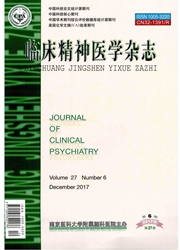

 中文摘要:
中文摘要:
目的:通过任务态功能磁共振(f MRI)扫描,分析广泛性焦虑障碍(GAD)患者与正常人在不同情绪图片刺激下的脑功能变化,探讨GAD患者认知监控网络(CCN)的功能异常。方法:对20例GAD患者(实验组)和14名健康对照者(健康对照组)在不同的情绪图片刺激下进行f MRI扫描,比较两组被试CCN脑区的差异。结果:以中性情绪为基线对照,在观察高兴情绪图片时,实验组被试左岛盖部额下回(MNI:-51,15,21;t=-5.178;P〈0.05)、左顶下小叶(MNI:-42,-42,48;t=-4.055;P〈0.05)、左侧补充运动区(MNI:-9,12,54;t=-4.778;P〈0.05)激活减弱;在观察恐惧情绪图片时,实验组被试右背外侧额上回(MNI:24,24,51;t=5.375;P〈0.05)激活增加。结论:CCN的功能异常可能与GAD的发病机制有关。
 英文摘要:
英文摘要:
Objective: To investigate the difference between GAD and health adults in CCN by fMRI scan. Method:We recruited 20 subjects with GAD and 14 matched healthy subjects to fMRI scan,and ana- lyzed the difference between the two groups. Results: In task-related condition, positive pictures decreased activation of left inferior parietal lobe ( MNI : - 42, - 42,48 ; t = - 4. 055, P 〈 0. 05 ), left supplementary motor area(MNI: -9,12,54;t = -4. 778,P 〈0.05) and left inferior frontal gyrus(MNI: -51,15,21;t = -5. 178, P 〈 0.05 ) in GAD patients ; negative pictures activated right dorsalateral superior frontal gyrus ( MNI : 24,24, 51 ; t = 5. 375, P 〈 0.05 ) in GAD patients. Conelusion: Our results suggest that GAD patients have the abnor- mal activity in CCN,which may be associated with disease mechanism for GAD.
 同期刊论文项目
同期刊论文项目
 同项目期刊论文
同项目期刊论文
 期刊信息
期刊信息
